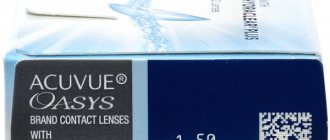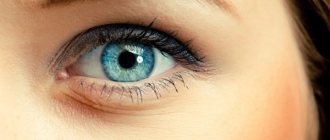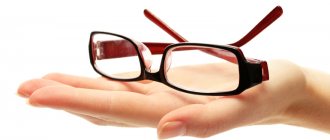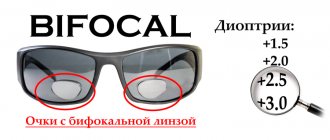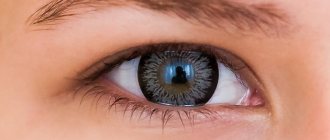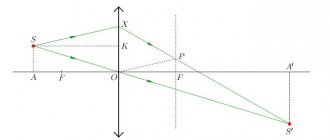Why are there different expiration dates for lenses?
Contact lenses are the most convenient method of vision correction.
To use them effectively and protect your eyes, you must follow the rules for their use. The product is made of ultra-thin, transparent and elastic material. It is suitable for almost any person with visual impairment because it does not cause allergies or irritation of the mucous membranes. The thinner the correction material, the shorter the period of its use. A softer product accumulates protein deposits, fats and mineral elements faster. The frequency of product replacement depends on its service life, which is set by the manufacturer:
- Daily (disposable correction products);
- Weekly (purchase of a new pair is required once every seven days);
- Planned (wearing period lasts from one to three months);
- From six months or more.
To avoid deterioration of the eye condition, it is necessary to strictly adhere to the regime of wearing lenses and monitor their hygiene.
Having trouble choosing? Contact us, the doctors at the Elite Plus clinic will help you choose the appropriate contact lenses based on the individual characteristics of each patient.
Can I use lenses for longer than the recommended period?
Some patients, in order to save money, wear contact vision correction products much longer than prescribed.
Such actions are strictly prohibited due to the high risk of inflammatory processes. During wear, microcracks and dry areas appear on the surface of the lenses. They cause a feeling of discomfort and irritate the mucous membrane of the eye. In addition, the material from which the lenses are made, like a sponge, absorbs dust, dirt, and protein deposits.
The surface of the correction products is compacted and prevents the enrichment of the cornea with oxygen. As a result of hypoxia, vision deterioration and the formation of new ophthalmological diseases are possible.
Lens manufacturers and ophthalmologists at the Elite Plus clinic categorically do not recommend wearing any contact lenses for longer than the prescribed period!
Why can't you rewear your lenses?
During use, various deposits are deposited on contact lenses, and dust and dirt adhere to the surface of the lenses. Despite the fact that current lenses are made from a biocompatible material that is quite resistant to deposits. But after some time, the level of resistance gradually decreases and deposits penetrate into the pores of the lens, destroying its surface and creating a favorable environment for the growth of bacteria. Using contact lenses after the replacement period is fraught with the development of eye diseases.
If you use the lens for longer, non-wetted areas may appear, which create a feeling of dryness of the eye and the presence of a foreign body. Breathability is also reduced as the pores of the lens become clogged with deposits, deposit buildup reduces the smoothness of the lens surface, and visual acuity is reduced.
Consequences of violation of the wearing period
The wearing time of contact lenses depends on the quality of the materials and the manufacturer. But regardless of the brand and price, you cannot use it after the specified wearing period.
The absence of discomfort while wearing expired vision correction products does not exclude the occurrence of negative consequences for your eyes.
Wearing lenses longer than prescribed leads to the following ophthalmological diseases:
The hydrogel from which the product is made accumulates microelements from eye tears and has a detrimental effect on them. This leads to various complications.
Conjunctivitis
If the wearing period is exceeded, harmful viruses and bacteria accumulate on the surface of the product. They enter the organs of vision and infect tissues. Conjunctivitis is characterized by the following symptoms:
- Purulent discharge from the eyes;
- Redness of the mucous membrane;
- lacrimation;
- Edema.
At the slightest suspicion of this disease, you should immediately contact an ophthalmologist and begin treatment. If qualified medical care is not provided on time, conjunctivitis can become chronic.
If you are sick, do not use infected contact lenses!
Corneal edema
As the product is worn, it gradually allows less and less oxygen to enter the tissue.
The hydrogel from which it is made becomes denser over time, it puts pressure on the cornea and leads to its swelling. As a result of such pressure, a person’s vision becomes blurred, and he feels a sharp pain in his eyes. Rainbow circles also appear in front of the patient (when he looks at the light). To alleviate the condition, you should immediately remove your contact lenses and consult an ophthalmologist. The doctor will give recommendations in the form of special drops, as well as a vitamin complex. If treatment is started in a timely manner, after a couple of days you can return to contact vision correction.
Keratitis
When wearing contact vision correction devices for a long time, fatty deposits accumulate on their surface and damage the cornea.
In these microscratches, bacteria rapidly develop, which leads to the occurrence of keratitis. Inflammation of the cornea of the eye is accompanied by the following symptoms:
- Acute pain;
- Profuse lacrimation;
- Painful sensations when moving the eye muscles;
- Purulent discharge.
If any of the above signs of keratitis occur, you should immediately consult an ophthalmologist. Inflammatory processes in the cornea are very dangerous and often lead to complete loss of vision.
Reasons for prohibiting wearing for longer periods of time
A feature of daily lenses is the use of a fairly thin material that does not allow oxygen to pass through to the cornea and retains moisture on the surface of the eye. This is the main reason why they should not be worn for 2 days or more.
Depending on the manufacturer of this type of wear, they are packaged in disposable containers that protect them from bacteria, dust, dirt, and infections. When put on, the property is lost; deposits of protein and lipid nature accumulate on them faster.
There is no need to treat daily CLs with enzymes and cleaning solutions. Therefore, if the instructions are not followed, deposits react with tear fluid and lead to various infectious and inflammatory diseases, eye irritation and allergic manifestations.
The maximum time of use per day is up to 12 hours. Exactly how long you are allowed to wear a particular brand of CL is indicated on the packaging. If the period is exceeded, the supply of air, in particular oxygen, to the cornea of the eye deteriorates, its nutrition and blood supply are disrupted. As a result, oxygen starvation occurs. If you do not contact a specialist in a timely manner, wearing lenses may become impossible in the future, because swelling and vascular ingrowth develop.
What can affect the quality of lenses
Contact corrective lenses sometimes deteriorate before the wear period stated by the manufacturer. If the products are not used carefully, they may become torn or scratched. Of course, you can no longer wear a spoiled product. They must be recycled.
Hydrogel is a delicate material. It is easily susceptible to negative influences, which significantly brings the purchase of a new pair closer. Reasons affecting the quality of correction products:
- Harmful microorganisms - microbes multiply very quickly in any microcrack on the surface of the lens. They lead to infectious eye diseases and damage the product;
- Aerosols - any fumes (varnishes, paints, cigarette smoke) accumulate on the shell of the vision correction product and interfere with oxygen supply to the cornea;
- Lack of hygiene – reusable use of solution for contact vision correction products; poor cleaning causes damage to the product.
Please remember that you should only touch the lenses with clean hands. If you do not wash off the layer of sebum, it will settle on the correction products and clog their pores.
When caring for soft contact lenses, we recommend using special fat-breaking solutions to clean the lenses.
Care
Proper care of biweekly lenses involves washing them daily, disinfecting them, and storing them overnight in a container specially designed for this purpose. Due to this care, harmful bacteria are completely removed from the surface of the lenses, in addition, the lens itself is moisturized, which will make it more comfortable during subsequent wear.
Lens storage container
Washing
The best time to clean your contact lenses is immediately after you take them out. It should be done like this:
- To begin, you need to carefully place the lens on your palm.
- Next, you need to apply a small amount of cleaning solution to it. After this, the surface of the lens should be gently wiped with your finger.
- After this, the lens should be rinsed in a small amount of a special solution and placed in a clean container.
- Now you need to repeat all this for the second lens.
Licortin - lens rinsing solution
It should be remembered that only special products can be used to clean such optics. Under no circumstances should ordinary running water be used for this purpose, since in most cases it is the source of infections.
Disinfection
Lenses need to be disinfected daily. To do this, simply place them in a storage container filled with a special solution. You need to keep them there for four hours, no less. Only after such processing can they be reused.
ReNu – solution for lenses
Only specialized solutions can be used for such processing of optics. It is best to take drugs from the same company that produced the lenses themselves - they are the most compatible.
Storage
Two-week replacement lenses should be stored in a special solution in a closed container. You cannot put them in a container without solution - otherwise the lens may dry out.
Lens storage
You need to change the liquid for storing lenses in the container daily. You should wash it with the same regularity using special products. Otherwise, various pathogenic bacteria may develop in this environment.
How long can you wear contact lenses?
The period of continuous wearing of vision correction products depends on their type.
There are two large groups of corrective lenses: soft contact lenses (daytime SCLs) and night wear lenses. The manufacturer must indicate on the packaging the mode of use of the product:
- Soft day and night lenses – service life up to 14 hours a day;
- Extended wear SCLs can be left in place for a week;
- Continuous wear lenses - these corrective lenses are used for a month without interruption.
High-quality SCLs can be worn continuously for decades.
Products made from silicone hydrogel are highly breathable and will not cause vision impairment. Subject to sanitary and hygienic standards and the use of an effective cleaning solution, the products can be used daily. But even the highest-quality SCLs need a break. Experts recommend replacing them with glasses at least several times a year for one day.
Night lenses are a new product in ophthalmology. They are a product made of breathable material that is worn at night. After using them, the patient's visual function is completely restored.
Terms of wearing lenses
Contact lenses are designed for daily wear. Depending on the type of device, it is possible to extend the use of the product:
| Type of lenses | Time of continuous eye contact |
| Daytime view | 12-14 hours |
| Night wear | 8-10 hours |
| Flexible wearing period | Up to 12 hours + 2 or 3 nights in a row |
| Extended wear | 7 days and 6 nights |
| Continuous use | 30 days |
| Quarterly type | 3 months |
Colored lenses differ significantly in the material used to make them from vision correction devices. They are less breathable, which reduces their wearing time. Overuse of such products threatens to impair the functionality of the cornea. The device can be worn for no more than 4 or 5 hours a day. If there is eye discomfort, the product should be removed.
We recommend reading: What lenses can you sleep in?
The period of wearing the product depends on the material of manufacture and its ability to accumulate natural material from the mucous membrane of the eyes. The thinner and softer the substance used to develop the product, the more active the cumulation reaction occurs. Therefore, daily lenses are the most comfortable to wear, but within a day they are no longer suitable for further use.
When wearing a vision correction device throughout the day, the period of planned replacement is reduced by half.
What happens if you wear lenses longer than prescribed?
When wearing contact lenses for scheduled replacement, it may be tempting to continue wearing them after the replacement period has expired. But in no case should you increase the period of wearing contact lenses determined by the manufacturer .
If you wear hydrogel contact lenses, you need to know that they are designed for daytime wear only, that is, for 8-10 hours. You cannot sleep in such lenses.
Silicone hydrogel lenses can be used in extended wearing mode, that is, they can be worn for more than 12 hours, while sleeping, etc. However, this is only allowed periodically. If you want to wear your lenses without removing them, then you should choose continuous wear lenses.
If you wear daily lenses, under no circumstances should you re-wear them the next day. If you know that it is time to replace a pair of contact lenses with a new one, but you feel good and do not experience any problems, then be sure to replace them anyway. Let's figure out why you shouldn't wear contact lenses.
When contact lenses expire, various types of deposits from tear fluid, the environment, and from the hands begin to accumulate on their surface. They begin to destroy the surface of the contact lens, which leads to eye irritation, as well as blurred vision and the possibility of infection in the eye . So timely replacement of contact lenses is the key to eye health and comfortable lens wearing.
Also, when wearing contact lenses longer than expected, due to deposits, oxygen access to the cornea of the eye worsens . A constant lack of oxygen, which is necessary for the normal metabolism of corneal cells, can lead to corneal hypoxia, which will subsequently develop into corneal edema, ingrowth of newly formed vessels, blurred vision, and infection . After such serious complications, you may leave the ranks of happy contact lens users.
Therefore, when an ophthalmologist evaluates the condition of your eyes at a slit lamp (the stages of the examination are described in detail in the article “How to select contact lenses”) and advises you to wear lenses only for a certain time, you need to strictly follow his recommendations .
This is due to the fact that contact lens material is obtained by polymerization of monomers, when a liquid prepolymer is first obtained, and then it solidifies into a polymer. It is known that contamination of the polymer surface is inevitable even under vacuum conditions. Polymers are divided into nonionic - those that do not carry any charge on their surface (or carry but a weak electrical charge) and ionic - they carry a significant electrical charge on their surface, thereby attracting from the tear fluid everything that has another charge.
Thus, during wearing, upon contact with tears, lipids (fats), proteins (protein), dirt (cosmetics, dust) remain on the surface of the lens in the “pores” . The composition of tears is different for everyone and depends on diet, on the functioning of the meibonium glands (secretory glands located along the edge of the eyelids), on the composition of the air where you spend most of your time, and on the rules of personal hygiene.
Of course, daily cleaning of the lens eliminates contamination, but over time, contamination reaches a level where the lens becomes an excellent environment for the development of microorganisms (bacteria) , which, when they begin to develop on the lens, certainly lead to the development of inflammatory diseases (conjunctivitis, keratitis).
What else does sediment accumulation lead to? 1. Non-wettable areas appear on the surface of the lens, which causes a feeling of dryness. 2. Deposits close the pores of the lens, thereby reducing its oxygen permeability. 3. Deposits saturate the entire structure of the lens, making its surface uneven, which can lead to deformation and rupture of the lens. 4. The surface of the lens becomes foreign to the eye, which leads to the formation of antibodies and allergic reactions. 5. Wearing lenses becomes uncomfortable, which can cause a decrease in visual acuity.
Conclusion: overwearing contact lenses and artificially extending the period of wearing them is extremely undesirable for the health of your eyes . Only following the basic rules of lens care can guarantee you clear and precise vision.
How to choose between glasses and lenses: 6 questions to an expert
Contact lenses require careful care and can cause discomfort; glasses fog up when the temperature changes and sometimes put pressure on the bridge of the nose - sometimes it can be really difficult to decide on the choice of vision correction. Heroine will tell you which lenses are the most modern, in which cases you should prefer glasses over lenses, and what to look for when buying them.
Regina Optics is an optical company where you can purchase contact lenses of any degree of complexity and purpose - stigmatic and astigmatic, single vision and multifocal (progressive), as well as glasses - sunglasses and with a polarizing filter (including diopters), for daytime driving and night time, for working at the computer and image. If desired, you can install new lenses in your favorite frame. We talked with Regina Optics CEO Victoria Kanziber and asked her questions that may concern anyone who can’t decide between glasses and contact lenses.
1. In what cases is it better to replace glasses with lenses?
Lenses have an obvious advantage when a person is engaged in active sports or activities that require maximum vision, not limited by the frame of glasses. They should also be given preference in case of amblyopia, when visual acuity is reduced and is not completely corrected by glasses or lenses, and high anisometropia, when the difference in eye refraction is more than 2-3 diopters. For example, if one eye has a visual acuity of -1 diopter, and the other -5, then wearing glasses will be problematic, especially for adults.
2. How many hours in a row can you wear lenses without changing them?
Lenses are divided into hard gas-permeable and soft: the former are used for the treatment of ophthalmological diseases, the latter for the correction of refractive errors. Outdated hydrogel lenses can be worn no more than 8 hours a day. If you increase the wearing period, chronic hypoxia occurs and, as a result, the ingrowth of blood vessels into the cornea.
Modern silicone hydrogel lenses can be worn up to 12-14 hours a day, and some, with very high oxygen permeability, can be worn in a prolonged mode, from a week to a month, without taking them off at night.
There are now improved silicone hydrogel lenses with moisture on the market. Computerization of workplaces and active work with gadgets provokes the development and aggravation of dry eye syndrome, and not only in contact lens wearers. Third generation lenses in this case provide more comfort during the day; they can be left on the eyes for up to 16 hours.
It is important not to forget about the planned replacement of lenses from the moment the blisters are opened. If these are one-day lenses, then we wear them for one day; if they are extended-wear lenses, we wear them in accordance with the terms specified by the manufacturer. After the expiration date, the lenses must be replaced, even if during this time you only used them once or twice.
Choose contact lenses
3. Is it true that lenses are better and more modern than ordinary glasses?
Lenses certainly give freedom. This is relevant for people leading an active lifestyle. With the help of cosmetic lenses, you can change the color of your iris, creating a new look. But glasses, despite the fact that they have a much longer history, still do not lose their relevance and are a stylish accessory. Just look at famous politicians, TV presenters or show business stars - most of them use corrective glasses.
It is not necessary to order only prescription glasses. Many people order fashion glasses or glasses for special purposes. For example, for working at a computer, which help people with good vision to maintain longer eye performance without strain and fatigue, and therefore good vision.
4. What should you look for when choosing lenses and glasses?
First of all, on the quality of materials. Soft contact lenses should be chosen from modern silicone hydrogel materials that can be worn throughout the day. It should be remembered that the shorter the wearing period, the less contact with the bacterial environment, and the safer and more comfortable the lens is for the eye. From this point of view, one-day lenses are considered the best - put them on, take them in, take them off and throw them away. But they are also the most expensive. Although this option is beneficial for those who mainly use glasses and wear lenses on certain occasions.
Any lenses should be selected by a specialist. And it’s not easy to write out a prescription and send it to the cashier – the patient must wear trial lenses. Using a special device, the doctor must verify the quality of the lens fit on the cornea, and then give the opportunity to walk around in them for 10-15 minutes to assess comfort. If several options are suitable, taking into account the characteristics of the cornea, the patient himself chooses what is more convenient for him. If there is no significant difference, then the patient is prescribed all suitable lens options, and he decides for himself what to buy, taking into account the wearing period and cost of the lenses.
When choosing glasses, you need to focus on the quality of the frame and its material, choosing acetate, steel, titanium and nylon. The comfort of wearing, the appearance of the glasses, strength and durability will depend on this. Particular attention should be paid to the fit of the frame on the face, the ability to adjust the temples and nose pads. In plastic frames, nose pads are rare; here there is a molded nose bridge, so we immediately note whether it is comfortable or not.
Spectacle lenses are the main component of glasses. The quality of vision and adequate brain function directly depend on their quality. Therefore, you should not save on lenses. It is better to choose a cheaper frame. The main thing is that the manufacturer is known and has established itself in the optics market.
5. What if I feel uncomfortable wearing lenses, but don’t want to switch to glasses?
If you feel uncomfortable wearing lenses, you need to sort it out. Properly selected lenses should not cause discomfort if used correctly. If a person does not overwear his lenses, carefully maintains hygiene, takes a break from lenses at least 1-2 times a week and wears glasses, then he will not have problems with contact lenses. A lot of people now suffer from dry eye syndrome, even those who do not wear contact lenses. Dry eyes occur due to insufficient wetting of the cornea when blinking. This is affected by prolonged work at the computer and with gadgets, smoking, including passive smoking, heating devices, and air conditioners. Taking certain medications also causes dry mucous membranes, which makes wearing lenses uncomfortable.
Now on the market there are many moisturizing, lubricating and restoring tear film drops that help fight dryness and have a therapeutic or preventive effect. However, in some cases they may be ineffective. If you don’t want to wear glasses, there is an alternative, radical method of correction - laser, which, in turn, has side effects and irreversible consequences.
6. What are the advantages of lenses and what are the advantages of glasses?
Before choosing between lenses and glasses, you need to keep in mind that one is not necessarily better than the other; they have their pros and cons in terms of ease of use and eye health. The advantages of lenses are freedom, unlimited visibility, almost real perception of the surrounding world, in some cases with lenses you can give the patient better vision than with glasses, with the help of lenses you can change the color of the iris. However, lenses cannot be worn for diseases associated with inflammation of the mucous membranes of the eyes, nose, and throat. Astigmatic (toric) contact lenses have a cylinder restriction.
Glasses provide an almost unlimited possibility of making a prescription and, unlike lenses, they can be worn during acute respiratory infections, severe allergic reactions or attacks of bronchial asthma. With the help of glasses you can create a unique, memorable image. Plus, mid-priced glasses ($100) are much cheaper than buying lenses and solutions over a long period of time.
Find glasses at REGINA OPICS
Add to favorites
Share
eyes
lenses
Related articles: Japanese eye drops designed specifically for girls
How I did laser vision correction
10 mistakes you make with lenses
6 Quality Contact Lens Brands
Is it possible to wear contact lenses overtime?
Is it possible to wear contact lenses overtime?
Contact lenses are a convenient and highly effective way to correct vision. But in order for them to be comfortable and safe for the eyes, they must be carefully looked after and the regime of their use must be strictly followed.
Research shows that the majority of contact lens users periodically violate their wearing regime and the timing of replacement, and this is fraught not only with discomfort and blurry images, but also with a decrease in visual acuity and the occurrence of eye infections.
How long can you wear contact lenses?
Manufacturers' recommendations regarding the wearing regimen and replacement period for contact lenses are carefully measured. The fact is that each brand of lenses has its own resistance to protein deposits and dirt, as well as its own level of oxygen permeability of the material. These indicators are extremely important for the normal use of lenses, the effectiveness of contact correction, and most importantly, for the health of patients’ eyes. Therefore, these recommendations cannot be neglected.
According to the wearing mode, contact lenses can be daytime, flexible, extended and continuous (without removing for up to 30 days). Each category has its own indicators of resistance to deposits and gas permeability.
Daytime contact lenses must be removed in the evening and placed in fresh lens solution so that they are cleaned of all contaminants and moisturized overnight. If you use daily contact lenses, throw them away after removing them; they should not be reused under any circumstances - their resistance to deposits is not designed for such long-term use. Hydrogel contact lenses are almost always designed for daytime wear because they allow little oxygen to pass through to the cornea. You should absolutely not sleep in hydrogel lenses. If you wear them longer than the period specified by the manufacturer, hypoxia of the cornea will begin, which can lead to its overgrowing with blood vessels and swelling.
How to use lenses
Using this type of lens is not at all difficult. Before you start using these optics, you will need to purchase a storage solution for them, as well as a special container in which you will keep them at night. There is no need to store such products in the blister in which they were sold.
You need to put these lenses on 15 minutes after waking up. If you have very dry corneas, you can use medications like artificial tears to moisten them (this will need to be discussed with your ophthalmologist). You will need to put on the lenses like this:
- First, you should wash your face and hands thoroughly. This is necessary to ensure that the lens itself does not get any infection.
- Next, you will need to open the container with the lens and remove the optics from the solution . The lens itself will need to be carefully placed on the pad of the index finger.
- After this, you will need to stretch the eyelid with two fingers of your free hand and apply the lens to the mucous membrane so that it covers the pupil. After this, you should blink a little so that the product finally falls into place.
- Now the same thing needs to be repeated with the second lens. After this, all you have to do is pour the old solution out of the container and put away all the tools that you use to work with lenses.
You need to remove the lenses 8 hours after you start wearing them. You should not delay this, as you may experience dry eyes and other unpleasant symptoms.
You can use such lenses for 14 days, but no more. Violating this rule may cause you to develop infections.
How long can you wear lenses and why can’t you wear them over?
Contact lens wearers should pay special attention to infectious and inflammatory eye diseases, since for this category of people the likelihood of their occurrence is much higher than for others. There is often a temptation to continue wearing “contacts” even after the scheduled replacement period has expired - many regularly sleep in lenses and violate the service life specified by the manufacturer, but this should never be allowed, because such negligence is fraught with the most negative consequences! Each model has its own service life, compliance with which ensures maximum safety for eye health. So, today I will tell you how long you can wear lenses .
Lenses have a service life that should not be violated.
Why is postterm pregnancy dangerous?
If you do not replace lenses in a timely manner, the consequences can be the most unexpected.
- various deposits appear on products , including protein deposits. Simply put, the lenses become dirty and if you use them longer than expected, the risk of infection will increase. Of course, daily cleaning with a multi-purpose solution eliminates contaminants, but at one “wonderful” moment they reach a level where they can cause inflammatory processes (keratitis or conjunctivitis).
- In addition, the surface, infested with deposits and microorganisms, becomes foreign to the eyes , as a result of which antibodies appear and allergic reactions occur.
- Over time, the material used in the manufacture of contacts undergoes irreversible changes . This means that if, for example, monthly models were worn only a few times, they will still have to be replaced, since the material is no longer suitable for use.
- Also, prolonged wearing can lead to oxygen “starvation” of the cornea (this is called hypoxia). This process is dangerous because it leads not only to serious impairments, but also to loss of vision. Each material used in the manufacture of contact lenses allows oxygen to pass through differently, which is why the expiration dates for all models are different.
- If you overwear the “contacts,” then so-called non-wettable areas , which causes a feeling of dryness and sand in the eyes.
- Finally, wearing it causes discomfort , which often leads to decreased visual acuity.
The consequences of post-term pregnancy can be the most negative, and discomfort is not the worst of them.
Conclusion: if you are interested in how long you can wear contact lenses, then the answer is - certainly not longer than the prescribed period. And we'll talk about this a little later.
On a note! According to ophthalmologists, the most favorable is daytime wearing, in which the devices are removed at night. But there are situations when wearing it at night is simply necessary.
Such situations include night shifts or, for example, visiting nightclubs. And during a hike, there are not always conditions for properly removing/putting on lenses. Therefore, you need to consult with a good specialist who will help you choose the most suitable model for you.
Who is suitable for two-week lenses?
Two-week contact lenses are not a luxury item or an element of a person’s style. They are an essential tool for those who want to correct their vision.
In what cases does a person need contact lenses:
- If an individual spends a sufficient amount of time at the computer every day (office work).
- If a person works or lives in a room with dry air.
- If you often feel tired in your eyes during the day.
- If a person suffers from farsightedness or nearsightedness. In this case, good contact lenses will be a better option than wearing glasses.
It is important to remember that extended-wear lenses need to be changed twice a month. You cannot wear them longer than expected because there is a risk of damaging the cornea of the eye.
How many hours can you wear contact lenses?
First, let’s figure out how long you can wear “contacts” without taking them off. To do this, let's go back to the very beginning, i.e. to the first days of wearing.
During the preliminary examination, the ophthalmologist will definitely inform you that the lenses require gradual adaptation. After all, despite all their advantages, they are foreign bodies that will initially cause discomfort. Therefore, the first week of wearing should last only a few hours: on the first day - 3-4 hours, in each subsequent period it should increase by about 1 hour. And in a week you will be able to wear “contacts” for 11-12 hours and still feel great!
Continuing the topic of how long a day you can wear lenses, I note: you need to focus first of all on which model you wear.
- One-day models, of course, will last only one day - about 9-12 hours. After this they need to be thrown away.
- For two-week, monthly, three-month old, etc. this period is the same (as for all hydrogel devices).
- For color devices (I will talk about them in more detail a little later) this is no more than 8 hours.
- But modern silicone hydrogel models can be worn for 15 hours without taking them off, and sometimes even sleep in them. There are even those that you can wear continuously for 7 or even 30 days (such as Acuvue Oasys, Air Optix Night & Day, etc.).
Wearing time depends primarily on what kind of lenses are used
Definition of two-week lenses
When choosing a vision correction product, it is very important to know all the subtleties and nuances of its operation. How to care for two-week lenses is a pressing question because they are now very popular.
The technology is simple. Any universal disinfection solution, which can be purchased at a pharmacy, is suitable for processing and storage. Enzymatic cleaning of lenses is not required. This is a significant advantage that allows you to protect yourself from an allergic reaction.
Manufacturers make lenses very thin, but at the same time durable. It is very difficult to break them. For ease of removal from the solution, manufacturers have provided a blue color. This way, you can remove the lenses from the container with the solution as carefully as possible without damaging them.
These contact lenses manufactured by Johnson & Johnson are the third generation of lenses. They are made of silicone hydrogel and contain a special moisturizer. Thanks to this, they protect the eyes from drying out, so they are comfortable to wear even in rooms with dry air. In addition, they have high oxygen permeability, which prevents corneal hypoxia and visual impairment. Acuvue Oasys lenses are softer than other types, making them suitable for even the most sensitive patients.
These means of contact vision correction are used for myopia or farsightedness. They can be used for varying degrees of myopia and even astigmatism. In addition, these lenses are recommended for teenagers and people switching from glasses to such products for the first time. They help maintain eye health and ensure clear vision. It is important that when wearing them you do not need to use additional moisturizing drops.
According to doctors, the safest are lenses that are changed every day. But for many patients they are not affordable. Therefore, most people choose two-week lenses, the best of which are Acuvue Oasys. These lenses are worn for 2 weeks, then they need to be replaced with new ones.
Provided you follow proper care and replacement schedules, these lenses are safe and comfortable. And compared to monthly wear products, they are easier to care for. The main thing is to regularly treat them with a multifunctional solution that ensures their cleaning, disinfection, moisturizing and proper storage.
Acuvue Oasis biweekly lenses must be changed twice a month. It is advisable to wear them only during the day, removing them before bed and treating them with a special solution. They do not require deep cleaning, so any universal product will do. Some types of these lenses can be worn continuously for a week, but after that they must be thrown away and replaced with new ones.
When choosing lenses, it is advisable to consult a specialist, since for this you need to know not only the degree of myopia. When purchasing, it is important to take into account the radius of curvature of the lens and its diameter. The comfort of wearing contact correction products also depends on this.
Two-week contact lenses are a type of corrective optics that must be replaced every 14 days from the moment the blister is opened. This type of contact lenses is an intermediate link between daily replacement and monthly replacement products. It has a more affordable price than daily replacement lenses, but it turns out to be much more comfortable to wear than samples that should be changed once a month.
The period of use of this type of optics should be counted from the moment the blister with lenses breaks, and not from the date of their purchase. After opening the package, such products must be stored in a special container filled with a disinfectant solution (the only exception is extended-wear lenses). You need to put on regular daytime lenses in the morning.
You need to remove the lenses 8 hours after putting them on (or earlier if you are just starting to wear such optics - in this case, reduce this interval to 4-5 hours). To do this, you will need to carefully slide the lens towards the edge of the eyelid, and then pick it up with two fingers.
What else affects the service life?
There are a number of factors that influence this parameter:
- thickness;
- individual tolerance;
- environmental pollution;
- chemical structure of the material;
- hydrophilicity (percentage of moisture content);
- manufacturing technology.
For example, thin models in which the moisture concentration reaches 50% (and these are mainly one-day and two-week products) have a short service life. But the individual characteristics of the user are extremely important - how he handles the products, what the composition of his tears is, whether he smokes, whether he follows the operating instructions.
The wearing period depends on a number of factors, including compliance with operating rules
Classification of “contacts” by duration of wear
- Traditional models can be worn for 6-9 months. If you take into account the cost, then at first glance this is the cheapest option, but if you add here the purchase of care products, multi-purpose solution and enzyme tablets, then these lenses no longer seem budget-friendly. Moreover, over time, the hydrogel material from which they are made ages, difficult-to-remove deposits form on it and, as a result, various infections. All this worsens visual acuity and you have to stop wearing it ahead of time. Often you have to buy only one contact - right or left, which complicates operation and causes overuse.
- Quarterly replacement models are worn for 3 months. This is a kind of intermediate link between traditional and plan lenses, which is practically not in demand.
- Planned replacement models are worn for 1 month, they can be either hydrogel or silicone hydrogel. They are convenient because, due to the short wearing period, there is no need for enzymatic cleaning (a regular multi-purpose solution is enough), and this allows you to save a little.
- Frequently scheduled replacement models are designed for one or two weeks. They are made from moisture-containing materials, making them absolutely safe for eye health even without thorough cleaning.
- Daily lenses. How long can you wear them? That's right, just one day: put it on in the morning, and take it off in the evening and throw it away. The safest models, because they are not treated with any solutions and are put on absolutely sterile. Maximum comfort, excellent quality of vision. The only negative is the high cost.
Video: What happens if you wear lenses for a long time?
How long can you wear colored contact lenses?
Colored models differ from corrective models in that, due to their softness, they prevent the normal flow of oxygen to the cornea . The result is pain and redness of the eyes. In addition, there are opaque models - the so-called disco lenses (for example, luminous lenses) - which complicate color perception, and if worn incorrectly, can lead to deterioration of vision.
Opaque (or disco) “contacts” interfere with color perception and can lead to vision impairment
On a note! The optimal time to wear colored “contacts” is no more than 4-5 hours a day. But if you notice tingling or blurred vision, then they need to be removed immediately. Although the specific timing, as I already noted, is individual and depends on the sensitivity of the eyes. And if 15 minutes after removal the “fog” has not passed, it means that your specific time has been exceeded.
Table. Wearing times for popular color models
| Model | Wearing period (in months) |
| Omniflex Soft Tint | Six to nine |
| Concor Color | Six to nine |
| Ultraflex | Six to nine |
| Soflens Colors | Three |
| Fresh Look | One |
| CRaZy | One |
| Focus Soft Colors | One |
| Calaview | One |
| Images | One |
| Color Tones | One |
| Acuvue 2 Colors | Two weeks |
| Acuvue 1 Day Colors | One day |
Otherwise, wearing colored lenses is practically no different from wearing regular ones - you can’t overwear them, you can’t sleep in them, you need to get used to them gradually, and clean them regularly.

